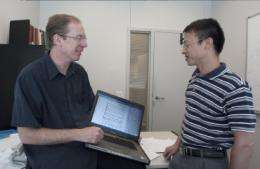Making a Magnetic Moment in a Split Picosecond

(PhysOrg.com) -- A wide range of phenomena in nature and technology depend on changes that occur in a material after it is illuminated with visible light. A well-known example is photosynthesis, where successive excitations by photons (light particles) leads to the production of oxygen from water. Other, more application-specific examples are solar cells and photocatalysis. Current research involves the study of iron molecular complexes, such as iron bipyridine, that after photoexcitation turn from nonmagnetic to magnetic.
After the absorption of a photon, the material is in an excited state, or in other words, it is no longer in equilibrium. The material will then decay to a more stable state. The decay can happen in less than a billionth of a second (a picosecond). Understanding nonequilbrium processes means understanding the behavior of materials in time. This is increasingly studied experimentally using “pump-probe” type experiments, where an optical laser pulse excites the material (the pump) and the time dependence after the excitation is studied using a variety of experimental probes, such as a high-brightness x-ray beam from the Advanced Photon Source. The use of x-rays as a probe is only recent, but will become more common in the future with the development of short x-ray pulses, such as those proposed in the Advanced Photon Source Upgrade and the coming on line of free-electron x-ray lasers such as the Linac Coherent Light Source at the SLAC National Accelerator Laboratory.
Obviously, one also wants to understand these nonequilibrium effects from a theoretical point of view. The Theory and Software Group at the Advanced Photon Source and the Department of Physics at Northern Illinois University (NIU) have developed a model that describes ultrafast transitions between two different states of a material. The focus was an iron-molecular complex that normally is nonmagnetic. However, when irradiating this material with visible light, the iron becomes magnetic in about 1/10,000,000,000,000'th of a second. In addition to the change in magnetism there is also a change in the distance between the iron and the organic material surrounding it. The question is why this material decides to go into a state with such different characteristics as opposed to simply returning to the original nonmagnetic state?
The answer requires the interplay of a surprisingly large number of different interactions. The charge density on the iron atom is generally directed away from the surrounding organic molecules. There exists a relatively small interaction, known as the spin-orbit coupling that has the ability to change the magnetic moment. A side effect of this interaction is that it will point the charge density towards the surrounding molecules. The molecules are pushed away by the Coulomb interaction and will start to oscillate around their new equilibrium positions. When they keep oscillating, not much will happen since the system will just return periodically to the initial state. However, due to the coupling of the system with the surroundings, the oscillations damp out and the iron no longer has an easy way of returning to its original nonmagnetic state. This system is now in a relatively long-lived meta-stable magnetic state. The theoretical research carried out by the Argonne-NIU group and published in Physical Review Letters gives a satisfactory explanation of the timescales and describes various regimes for the decay.
Although the iron molecular compound is an interesting compound in its own right, the findings for this material and the developed methodology open the door to the theoretical treatment of larger systems and to calculate the time-dependence of “pump-probe” x-ray experiments.
More information: Michel van Veenendaal, Jun Chang, and A. J. Fedro, “Model of Ultrafast Intersystem Crossing in Photoexcited Transition-Metal Organic Compounds,” Phys. Rev. Lett. 104, 067401 (2010). DOI:10.1103/PhysRevLett.104.067401
Provided by Argonne National Laboratory





















